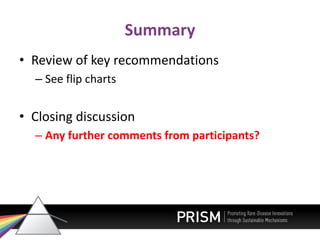CORD 2018 Fall Conference Day 1 Nov 8 - Slides
- 1. Making Market Access Programs (MAPs) Work
- 2. Facilitators • Tania Stafinski, University of Alberta, PRISM • Judy Glennie, PRISM PRISM – Promoting Rare-Disease Innovations through Sustainable Mechanisms
- 3. Objectives 1. To do a deep-dive to enhance our understanding of the potential role of MAPs for enhancing patient access to drugs for rare diseases (DRDs) 2. To work in multi-stakeholder groups to apply principles and methods of designing and implementing Managed Access Programs within the context of National Pharmacare, CORD’s Proposal for Access to Rare Disease Drugs, and the proposed FPT Process for Complex/Specialized Drugs 3. To place particular emphasis on discussion of the role of patients in MAPs.
- 4. Agenda Time Topic Presenters 1045am – 1245pm Workshop Introduction and Case Studies • Overview of MAPS • Workshop instructions • Case study group work • Report back Tania Stafinski, Judy Glennie PRISM 1245-130pm Lunch 130-215pm Working Groups: Refining MAPs • Participants will refine their proposed MAPs based on feedback and other proposed MAP designs with the goal of improving feasibility and sustainability. Tania Stafinski, Judy Glennie PRISM 215-3pm Summary and wrap-up • Review of key recommendations • Closing discussion Tania Stafinski, Judy Glennie PRISM
- 6. WHAT HAVE WE HEARD SO FAR • Patients need treatment options • There are lots of promising therapies • But significant uncertainty exists - Uncertainty over who and how many could benefit - Uncertainty over benefit and magnitude of benefit -> uncertainty over the value proposition
- 7. Working towards a shared goal of patient access that is: • Appropriate • Responsible • Sustainable WHAT HAVE WE HEARD SO FAR
- 8. WHAT WE HAVE HEARD SO FAR Regulatoryapproval Coverage Managed Access Programs (MAPS)
- 9. WHAT ARE MAPS? • Form of contractual agreement between manufacturers and payers • Provides patients with access to a drug: if it does what it is supposed to do, they stay on it, but if it doesn’t, they don’t • Ties outcomes to ongoing reimbursement • Real world evidence collected on outcomes around which there is uncertainty • Outcomes pre-specified • May be related to clinical benefit, cost-effectiveness, cost/patient, budget impact, etc. • Have been used elsewhere • Many different names
- 10. WHEN ARE MAPS USED? Unmet need Severe disease Small patient population Promising evidence of clinical benefit Limited evidence High decision uncertainty
- 11. THE BURNING QUESTION How can we create MAPs that ensure appropriate, responsible, sustainable access to therapies for rare diseases?
- 12. WORKSHOP INTRODUCTION AND CASE STUDIES
- 13. Case Studies 1. Complex (combination) Therapies 2. Gene Therapy #1 3. Drugs for Rare Diseases 4. Gene Therapy #2 • See case descriptions on tables • 2 groups will review each case
- 14. Process 1. Please take 5 minutes on your own to review your assigned case study 2. Pick at time-keeper 3. Pick a note-taker/reporter 4. Review the questions 5. Address the questions as a group ASSUMPTIONS: • We are assuming that, in fact, there should be a MAP for the drugs in each of the case studies. • We are starting with a blank slate – i.e., we are starting at the first part of the process for developing a MAP.
- 15. Questions – Part 1 1. Who should be involved in the design of your MAP? What would be role of each group involved? (NOTE: please do not spend any more than 5 minutes on this question!) 2. How should we decide who is eligible to participate in the MAP? Why? 3. How should we determine the “stopping criteria” for the MAP? Why? 4. What needs to be put into place to ensure that all stakeholders abide by the “rules” of the MAP? What kind of accountabilities should patients have as part of their role in the MAP? 5. How should the data from the MAP be used for decision-making?
- 16. Report Back • Short summary of case by facilitator • Comments on each case study by 2 groups assigned • Comments from other participants
- 17. LUNCH
- 19. Questions – Part 2 1. How would you change your considerations for your MAP based on what you heard during the report back? 2. What do you think needs to be considered/done in order to make your MAP feasible?
- 21. Summary • Review of key recommendations – See flip charts • Closing discussion – Any further comments from participants?
- 22. THANK YOU!
- 23. REFLECTIONS ON PROVINCIAL/TERRITORIAL PROPOSED EXPENSIVE DRUGS FOR RARE DISEASES PROGRAM Bill Dempster CEO 3Sixty Public Affairs November 8, 2018
- 24. New proposed “supplemental process” for complex / specialized meds – including rare disease drugs • Background • Created by the provincial and territorial health ministers • Led by BC, Alberta and Ontario public drug programs • Objective Implement a proactive, consistent, fair, transparent process to facilitate responsive funding decisions • Next steps • Consultation beginning this week and through late 2018 (CADTH supporting) • Working group will develop recommendations to health ministers • Potential implementation in Spring 2019 2
- 25. What the process envisions • Concurrent regulatory, evaluation and pricing reviews (Health Canada, CADTH, and PMPRB) • Followed by sequential pCPA negotiations and government drug plan listing decisions • Enhanced health technology assessment review • Consideration of managed access agreements • Enhanced use of real-world evidence • Adjudication process to address individual patient coverage requests by expert panels
- 26. Supplemental – not separate - process
- 27. Encouraging progress for rare disease community …but questions remain to be explored – for example: • How will health technology assessments be better equipped to evaluate rare disease drugs? • What will change for clinicians? (e.g., adjudication / exceptional access / input into process) • How will the process ensure that the right experts are providing advice? • How can patients and clinicians participate in real world evidence programs? • How will patients know when & how they can expect a decision on a specific rare disease treatment?
- 28. Implications
- 29. Discussion
- 30. Thank you! William (Bill) Dempster CEO, 3Sixty Public Affairs wdempster@3sixtypublicaffairs.com (613) 800-8340





























